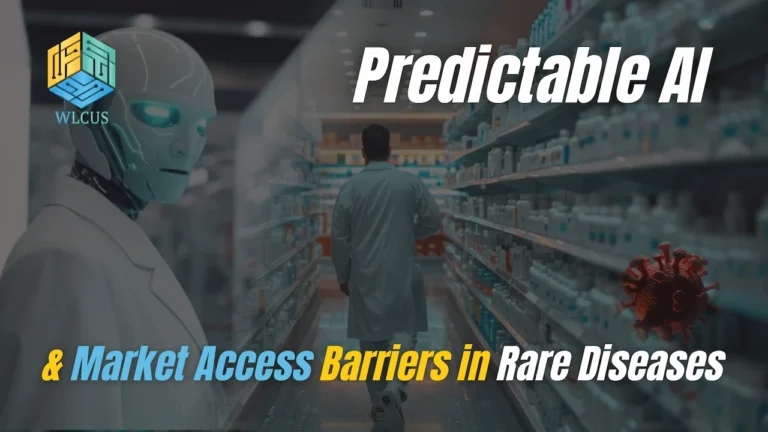AI for Predicting Market Access Barriers in Rare Diseases

Predicting market access barriers in rare diseases is a complex process.
AI is helping simplify this process by identifying regulatory, pricing, and reimbursement challenges before they emerge.
This article explores how AI can support pharma and biotech companies in improving market access planning for rare disease treatments.
Understanding Market Access Barriers in Rare Diseases
Rare diseases, also known as orphan diseases, affect a small portion of the population.
Due to limited patient populations, developing treatments is costly and risky. After development, ensuring access is even harder.
Market access refers to a therapy’s ability to reach patients through approval, pricing, reimbursement, and distribution.
Barriers in this area include:
- High development costs leading to expensive drugs
- Limited clinical trial data
- Country-specific pricing and HTA criteria
- Delayed or denied reimbursement
- Inconsistent regulatory frameworks across regions
Traditional approaches to overcoming these obstacles are reactive and slow.
Pharma companies face delays, rejected pricing submissions, or limited reimbursement scopes, costing millions and reducing patient access.
AI offers an opportunity to predict these barriers early, allowing stakeholders to take preventive actions.
By integrating data from regulatory outcomes, payer decisions, and clinical studies, AI models are now capable of forecasting access challenges.
The Role of AI in Identifying and Predicting Access Barriers
Artificial intelligence processes large, fragmented data sets to detect patterns that indicate market access risks.
These patterns include how pricing decisions correlate with trial endpoints, disease prevalence, and treatment alternatives.
AI models can assess:
- Historical health technology assessment (HTA) decisions
- Clinical trial design versus reimbursement success
- Regulatory response trends
- Economic burden data influencing price acceptance
Machine learning algorithms improve over time, making predictions more accurate as more data becomes available.
Natural language processing (NLP) helps extract payer sentiment and policy shifts from unstructured documents like HTA reviews.
Predictive analytics provide early warning signs for price rejection, reimbursement delays, or negative HTA opinions.
With this insight, companies can revise clinical endpoints, adjust launch sequencing, or redesign pricing models.
AI transforms access planning from reactive to proactive, minimizing surprises during post-approval stages.
Real-World Applications: How AI is Being Used Today
Several biotech and pharmaceutical companies are already applying AI to rare disease market access strategies.
They are using AI to optimize pricing, forecast reimbursement potential, and predict submission outcomes across various countries.
Below are key areas of implementation:
Use Cases in Pricing and Reimbursement Forecasting
AI models analyze past pricing and reimbursement decisions to anticipate potential bottlenecks.
For example, a company launching an enzyme replacement therapy can input trial design, treatment costs, and disease prevalence.
The AI system matches this data to similar past cases, suggesting likely HTA decisions in target countries.
This reduces the risk of pricing misalignment and guides pre-submission adjustments.
It also identifies which markets are most receptive, supporting smarter launch sequencing.
Predictive Models for HTA Success Rates
AI can estimate the probability of a positive HTA outcome based on therapy profile and submission data.
Factors include clinical trial endpoints, comparators, cost-effectiveness, and budget impact.
For rare diseases, where HTA decisions often rely on limited data, predictive models fill in the gaps using proxy indicators.
This helps teams prepare stronger dossiers, improve evidence generation plans, and justify higher price points.
Benefits of Using AI in Rare Disease Market Access
AI improves decision-making speed and accuracy. It reduces guesswork by offering evidence-based predictions.
Key benefits include:
- Early identification of reimbursement hurdles
- Reduced submission rejections or revisions
- Optimized pricing strategies per market
- Faster time to patient access
- Cost savings through reduced delays and errors
Companies can allocate resources more effectively, focusing efforts where success is more likely.
For patients, faster access means earlier treatment, which is critical in progressive or life-threatening conditions.
AI-driven insights also support collaboration between regulatory, commercial, and medical teams.
Everyone works from a shared understanding of risk, supported by data instead of assumptions.
Challenges and Limitations of AI Implementation
Despite the advantages, AI in market access still faces limitations.
Data quality is a major concern. In rare diseases, datasets are often small, fragmented, or region-specific.
Without sufficient high-quality data, AI models may generate misleading forecasts.
Interpretability is another challenge. Stakeholders may not trust black-box predictions without clear explanations.
Also, payer environments and HTA criteria evolve constantly. AI models must be updated frequently to stay relevant.
Implementation requires cross-functional coordination, technical skills, and financial investment.
There’s also a risk of overreliance, where decisions are based solely on AI outputs without human judgment.
Companies should treat AI as a decision support tool, not a decision maker.
What’s Next for AI in Market Access
The future of AI in rare disease market access is promising.
Continued investment in data sharing and interoperability will enhance model accuracy.
Federated learning can allow companies to train AI on sensitive data without compromising privacy.
Regulators may also begin to accept AI-generated insights in submission documents, particularly for access planning or risk mitigation strategies.
We can expect AI tools to become more user-friendly, enabling non-technical teams to use them effectively.
As more real-world data becomes available, prediction capabilities will improve even further.
Collaboration between AI developers, pharma companies, and HTA bodies will shape the next evolution in access strategy.
Conclusive Thoughts
AI offers a powerful approach to anticipating and addressing market access barriers in rare diseases.
By combining data-driven forecasting with strategic planning, companies can improve launch outcomes and expand patient access.
The technology is not a replacement for expertise, but a complement to informed decisions.
To benefit fully, pharma stakeholders must focus on data quality, model transparency, and cross-functional alignment.
The sooner AI is integrated into early planning, the more impact it can have on outcomes
